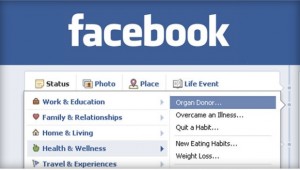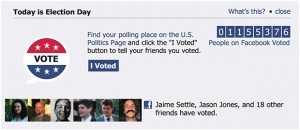How Facebook Can Prompt Real-Life Action
This is a guest post.
Given its role in the Arab Spring, many people have emphasized Facebook as an effective tool for online activism. There’s much debate on the ability of Facebook to effect social change, but a handful of campaigns by the social networking site over the past several years have demonstrated just how powerful social media might be in prompting real-life actions.
On May 1, 2012, Facebook rolled out a new feature allowing users to share their status as an organ donor on their timeline. A study published last month in the American Journal of Transplantation shows that the experiment coincided with an incredible spike in organ donor sign-ups in the United States—13,012 on the first day of the campaign, or 21 times the daily average number of registrations. The organ donor registration rate remained higher than average for nearly two weeks.
Although the registration rate tailed off 12 days later, it was still two times higher than the average baseline rate by the end of the study period. By the end of two weeks, the number of new registrations reached nearly 40,000. In an article in Slate, study author and Johns Hopkins associate professor Andrew Cameron said that “Having [organ donor registration] be on Facebook makes it easier for people.” The next step will be to find ways to sustain the gains in donor sign-ups. As noted by Cameron, “we need to find a way to keep the conversation going”.
A second study, published last fall in Nature, showed similar results with respect to voter turnout. The study authors worked with Facebook to randomly display to Facebook users either: 1) a message encouraging them to vote along with a link to polling places, an “I voted” button to click, up to six profile pictures of friends who had clicked the same button, and a total count of all friends who had reported voting; 2) the same message, without the photos or friend counter; or 3) no message. By examining voting records, the authors were able to determine that users who received the first message were 0.39 percent more likely to vote than users who received no message—an effect the authors say led directly to an increase in voter turnout by 60,000.
Early last year, Peter Leone, a professor of medicine with University of North Carolina, began experimenting with Facebook as a tool for predicting and preventing STD transmission. While working with patients with HIV and syphilis, Leone concluded that the friend networks people have could reveal patterns about the spread of STDs. He reasoned that a person’s circle of Facebook friends often have similar risk-taking patterns, and are best way to spread information about the risk of infection—and that potentially, using Facebook to prompt people to be tested and encourage them to share information about testing could help destigmatize the process.
While debates continue about the affect of social media on events in Egypt, Turkey, Syria, and elsewhere, these early studies show that in some cases, what users see online can influence their real-world behavior.

